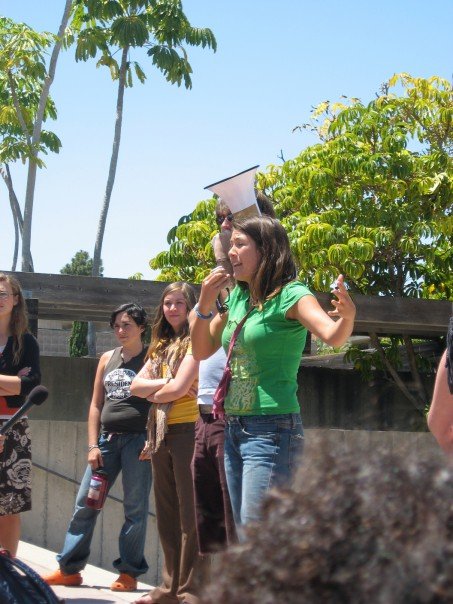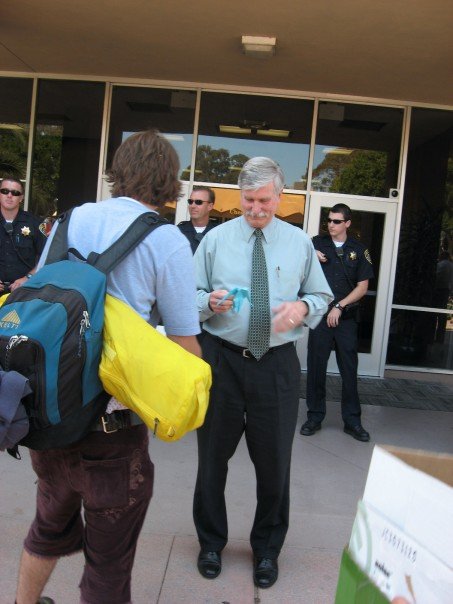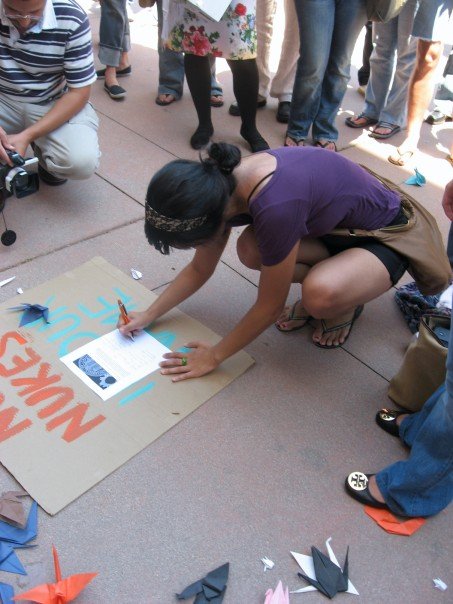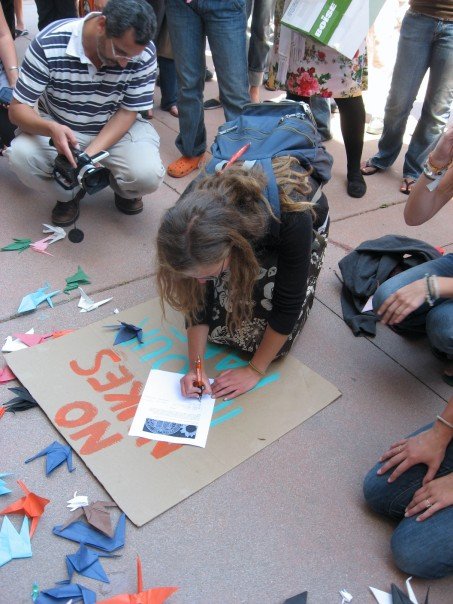From the Open-Publishing Calendar
From the Open-Publishing Newswire
Indybay Feature
UC Hunger Strike Against Weapons Labs Passes 1-Week Mark
A hunger strike initiated by 44 UC students, several alumni and a professor has passed its 1-week mark. The hunger strikers are demanding that the UC Board of Regents withdraw from their contracts to operate Los Alamos and Livermore National Laboratories based on, “the grounds that the Reliable Replacement Warhead program and Los Alamos Labs’ ongoing preparations to conduct plutonium pit manufacturing both clearly violate Article VI of the 1970 Nuclear Non-Proliferation Treaty.” The hunger strikers have put their bodies on the line in a time of enormous flux for US nuclear weapons policy. Their target, the UC, has been identified by them as a site of strategic importance in the wider campaign against new nuclear weapons.

Anchored by the Los Alamos and Lawrence Livermore National Labs and the small circle of corporations who run these and other weapons facilities for the federal government, the US nuclear weapons complex is hurriedly working to finalize designs for and to begin building a new nuclear weapon, called the Reliable Replacement Warhead (RRW). This program, if supported by the president and funded by Congress, will expend many billions of dollars on nuclear weapons over the next few decades and guarantee the longevity of the US nuclear weapons complex. It will also lead to a US violation of the nuclear Non-Proliferation Treaty, a global arms control regime that has mostly worked up to the present. Furthermore, the new US weapons program will necessarily produce many tons of nuclear and toxic waste and create un-imaginable opportunity costs.
RRW will guarantee a massive infusion of resources into the nuclear weapons labs and the various other facilities of the nuclear weapons complex(http://lasg.org/press/2007/PressReleaseMar2_2007.htm). The program will surely require the resumption of plutonium pit manufacturing which will take place at Los Alamos National Lab (http://lasg.org/PU_talking_points1.htm). It will be a nuclear weapons renaissance for the corporations that run these facilities.
RRW, plutonium pit production, and the various other practical steps being taken toward a new US nuclear weapons program are already in motion, even though the Congress has yet to commit itself to the mission. Nor have the armed forces committed to the idea of rebuilding the US arsenal. The public, mostly in the dark, would seem to be opposed to a new arms program: numerous polls demonstrate that the American people favor further reductions in the US arsenal and engagement with other nations to implement the NPT and other arms control treaties to the fullest extent possible(http://www.worldpublicopinion.org/pipa/articles/home_page/307.php?nid=&id=&pnt=307).
So where is the push for RRW and pit production coming from? Lobbyist for this new program include managers of the Los Alamos and Livermore Labs, Sandia National Labs, other facilities in the nuclear weapons complex, the corporations that operate these sites, and a powerful (but small) alliance of politicians and policy makers in the Congress and executive branch. For these parties, RRW will ensure the funds and mission that is necessary for the long-term survival of the US nuclear weapon complex. Their interests vary, but the financial profits that the complex brings, along with considerable political power and a continuing ideological commitment to nuclear deterrence are among the driving forces behind this pro-nuclear coalition.
The University of California’s role in this is primarily about legitimation. Through the Cold War the UC Regents operated the Los Alamos and Livermore National Labs for the federal government. At one time the UC’s administrative influence at the labs was high. Although the UC as an institution had little say over the programs and policies that the labs would push, certain members of the board of Regents, UC Office of the President, and members of the faculty (particularly physicists working with the labs) held considerable sway over US nuclear weapons policy. To clarify, this did not mean that UC operated these labs in a more transparent and enlightened way than the Honeywell Corporation did with the government’s Kansas City Plant, but rather that the highest circles of UC’s administration and the Board of Regents had influence with the weapons programs and policies shaped by the labs.
The advent of contract competition in 2003 for Los Alamos and later Livermore Labs (never before had UC’s labs been competitively bid for) signaled a wider transformation and a new era for the nature of UC lab management. As a result of contract competition both LANL and LLNL have effectively been privatized. They are now operated by private limited liability corporations called Los Alamos National Security, LLC, and Lawrence Livermore National Security, LLC. The UC Regents (not the University of California) are a junior partner in these companies, led by Bechtel Corporation and a number of other military-industrial firms that increasingly specialize in nuclear weapons and waste facility operations. The privatization of the US nuclear weapons complex is already a fact; more than 96% of the National Nuclear Security Administration’s appropriations are payments to corporate contractors (http://www.lasg.org/NNSAPrivatization.pdf).
UC’s major contribution to the US nuclear weapons complex has always been legitimacy. The primary function of the UC is its reputation as the leading public university. By grafting the University of California’s name to the weapons labs, the UC Regents effectively give the light of the university (as in “fiat lux”) to the mission of nuclear weaponry. Now more than ever this contribution gives strength to the weapons labs. It gives respectability to a mission that is increasingly rejected by the people of the United States and the international community. It gives an aura enlightened decision making and public trust to a mission that has already become privatized and profit driven.
The hunger strikers see their action as a strategic act of resistance against the RRW program, pit production, and the vast scoping process called "Complex 2030." They hope to galvanize action amongst UC faculty, staff and administration as well as the public to prevent a new arms race. On Thursday, May 17 the hunger strikers will attend the UC Regents meeting in San Francisco to demand the Board of Regents move for laboratory severance.
RRW will guarantee a massive infusion of resources into the nuclear weapons labs and the various other facilities of the nuclear weapons complex(http://lasg.org/press/2007/PressReleaseMar2_2007.htm). The program will surely require the resumption of plutonium pit manufacturing which will take place at Los Alamos National Lab (http://lasg.org/PU_talking_points1.htm). It will be a nuclear weapons renaissance for the corporations that run these facilities.
RRW, plutonium pit production, and the various other practical steps being taken toward a new US nuclear weapons program are already in motion, even though the Congress has yet to commit itself to the mission. Nor have the armed forces committed to the idea of rebuilding the US arsenal. The public, mostly in the dark, would seem to be opposed to a new arms program: numerous polls demonstrate that the American people favor further reductions in the US arsenal and engagement with other nations to implement the NPT and other arms control treaties to the fullest extent possible(http://www.worldpublicopinion.org/pipa/articles/home_page/307.php?nid=&id=&pnt=307).
So where is the push for RRW and pit production coming from? Lobbyist for this new program include managers of the Los Alamos and Livermore Labs, Sandia National Labs, other facilities in the nuclear weapons complex, the corporations that operate these sites, and a powerful (but small) alliance of politicians and policy makers in the Congress and executive branch. For these parties, RRW will ensure the funds and mission that is necessary for the long-term survival of the US nuclear weapon complex. Their interests vary, but the financial profits that the complex brings, along with considerable political power and a continuing ideological commitment to nuclear deterrence are among the driving forces behind this pro-nuclear coalition.
The University of California’s role in this is primarily about legitimation. Through the Cold War the UC Regents operated the Los Alamos and Livermore National Labs for the federal government. At one time the UC’s administrative influence at the labs was high. Although the UC as an institution had little say over the programs and policies that the labs would push, certain members of the board of Regents, UC Office of the President, and members of the faculty (particularly physicists working with the labs) held considerable sway over US nuclear weapons policy. To clarify, this did not mean that UC operated these labs in a more transparent and enlightened way than the Honeywell Corporation did with the government’s Kansas City Plant, but rather that the highest circles of UC’s administration and the Board of Regents had influence with the weapons programs and policies shaped by the labs.
The advent of contract competition in 2003 for Los Alamos and later Livermore Labs (never before had UC’s labs been competitively bid for) signaled a wider transformation and a new era for the nature of UC lab management. As a result of contract competition both LANL and LLNL have effectively been privatized. They are now operated by private limited liability corporations called Los Alamos National Security, LLC, and Lawrence Livermore National Security, LLC. The UC Regents (not the University of California) are a junior partner in these companies, led by Bechtel Corporation and a number of other military-industrial firms that increasingly specialize in nuclear weapons and waste facility operations. The privatization of the US nuclear weapons complex is already a fact; more than 96% of the National Nuclear Security Administration’s appropriations are payments to corporate contractors (http://www.lasg.org/NNSAPrivatization.pdf).
UC’s major contribution to the US nuclear weapons complex has always been legitimacy. The primary function of the UC is its reputation as the leading public university. By grafting the University of California’s name to the weapons labs, the UC Regents effectively give the light of the university (as in “fiat lux”) to the mission of nuclear weaponry. Now more than ever this contribution gives strength to the weapons labs. It gives respectability to a mission that is increasingly rejected by the people of the United States and the international community. It gives an aura enlightened decision making and public trust to a mission that has already become privatized and profit driven.
The hunger strikers see their action as a strategic act of resistance against the RRW program, pit production, and the vast scoping process called "Complex 2030." They hope to galvanize action amongst UC faculty, staff and administration as well as the public to prevent a new arms race. On Thursday, May 17 the hunger strikers will attend the UC Regents meeting in San Francisco to demand the Board of Regents move for laboratory severance.



Add Your Comments
Comments
(Hide Comments)
3. Consortium wins contract to run Livermore lab
The partnership, which is given a seven-year deal, includes the UC system, which has long run the facility.
Los Angeles Times
By Ralph Vartabedian, Times Staff Writer
May 9, 2007
The Energy Department on Tuesday awarded a seven-year contract to operate Lawrence Livermore National Laboratory to an industry consortium that includes the UNIVERSITY OF CALIFORNIA, which has run the lab since it opened in 1952.
This year the lab was selected by the Energy Department to design and develop a new generation of nuclear bombs, known as the reliable replacement warhead. A report by an independent group of scientists warned that the project faced serious technical challenges....
Meanwhile, three students and alumni at UC campuses in Santa Barbara, Santa Cruz and BERKELEY went on hunger strikes this week to protest the involvement of the university system in designing nuclear weapons.
Energy Department officials dismissed their demands.
"We urge students participating in this action to cease the strike and to eat," said Chris Harrington, a UC spokesman.
Other stories on this topic appeared in the Contra Costa Times
http://www.contracostatimes.com/portlet/article/html/fragments/print_article.jsp?articleId=5853388&siteId=571
San Francisco Chronicle
http://www.sfgate.com/cgi-bin/article.cgi?file=/c/a/2007/05/09/BAGTTPNKCU1.DTL&type=printable
and Oakland Tribune
Full Story
http://www.latimes.com/news/nationworld/nation/la-na-livermore9may09,1,4114330,print.story
The partnership, which is given a seven-year deal, includes the UC system, which has long run the facility.
Los Angeles Times
By Ralph Vartabedian, Times Staff Writer
May 9, 2007
The Energy Department on Tuesday awarded a seven-year contract to operate Lawrence Livermore National Laboratory to an industry consortium that includes the UNIVERSITY OF CALIFORNIA, which has run the lab since it opened in 1952.
This year the lab was selected by the Energy Department to design and develop a new generation of nuclear bombs, known as the reliable replacement warhead. A report by an independent group of scientists warned that the project faced serious technical challenges....
Meanwhile, three students and alumni at UC campuses in Santa Barbara, Santa Cruz and BERKELEY went on hunger strikes this week to protest the involvement of the university system in designing nuclear weapons.
Energy Department officials dismissed their demands.
"We urge students participating in this action to cease the strike and to eat," said Chris Harrington, a UC spokesman.
Other stories on this topic appeared in the Contra Costa Times
http://www.contracostatimes.com/portlet/article/html/fragments/print_article.jsp?articleId=5853388&siteId=571
San Francisco Chronicle
http://www.sfgate.com/cgi-bin/article.cgi?file=/c/a/2007/05/09/BAGTTPNKCU1.DTL&type=printable
and Oakland Tribune
Full Story
http://www.latimes.com/news/nationworld/nation/la-na-livermore9may09,1,4114330,print.story
For more information:
http://www.berkeley.edu/news/in_news/archi...
The board of regents was meeting today at USCF from about 1:30 to 3:30 and no one was there! I went with a friend of mine with a sign but no one showed up. The police wouldn't tell me through which door they were exiting. We waited outside by their chauffeurs, but my friend, who is in his 70's, didn't feel too good so we went back.
There were police everywhere. man...USCF is a huge corporate university
There were police everywhere. man...USCF is a huge corporate university
This story on the US Indymedia has "Save Darfur"s campaine to divest from pro Palestine Sudan linked as "related"
"Save darfur" is demanding the US government send 15-20,000 US troops to occupy the oil, uranium and gum arabic fields of the largest country in Africa.
how is that related to this ?
People should know that boston indymedia is a pro war site and they censor almost every anti war comment that gets posted. Boston indymedia has been siezed by racist jews from hillel house who are hell bent on overthrowing the government of Sudan and Iran and dont care how many arabs, africans or persians they have to kill to do it.
"Save darfur" is demanding the US government send 15-20,000 US troops to occupy the oil, uranium and gum arabic fields of the largest country in Africa.
how is that related to this ?
People should know that boston indymedia is a pro war site and they censor almost every anti war comment that gets posted. Boston indymedia has been siezed by racist jews from hillel house who are hell bent on overthrowing the government of Sudan and Iran and dont care how many arabs, africans or persians they have to kill to do it.
For more information:
http://www.bazabaza.blogspot.com
I would be for extending the hunger strike to a month. If the peaceniks don't like it, then they can use their peace techniques to convince me otherwise.
I can bet they would very quickly feel a great deal of empathy for the unfortunates in Darfur.
The Japanese were willing to have 30 million of their own people die at the end of WWII, so they would have the US negotiate with them. The Uranium bomb was correctly recognized by them as a bad miracle, but not something that could be reproduced. The Plutonium bomb was correctly recognized by the Japanese physicists as a technology that would lead to production of bombs at industrial rates. Only then did the Japanese surrender.
The plutonium bomb was a moral enough technology to save 30 million Japanese lives, not to mention the 1 million added US combat losses, and the another 300,000 US deaths due to US soldiers, marines, and airmen being starved to death in Japanese prisoner of war camps.
The only thing that is even close to life saving technology is DDT, but that was hindered because of Rachel Carson's very evil book "Silent Spring" which stoped the DDT from its lifesaving work for 40 years.
I can bet they would very quickly feel a great deal of empathy for the unfortunates in Darfur.
The Japanese were willing to have 30 million of their own people die at the end of WWII, so they would have the US negotiate with them. The Uranium bomb was correctly recognized by them as a bad miracle, but not something that could be reproduced. The Plutonium bomb was correctly recognized by the Japanese physicists as a technology that would lead to production of bombs at industrial rates. Only then did the Japanese surrender.
The plutonium bomb was a moral enough technology to save 30 million Japanese lives, not to mention the 1 million added US combat losses, and the another 300,000 US deaths due to US soldiers, marines, and airmen being starved to death in Japanese prisoner of war camps.
The only thing that is even close to life saving technology is DDT, but that was hindered because of Rachel Carson's very evil book "Silent Spring" which stoped the DDT from its lifesaving work for 40 years.
For more information:
http://paterzplace.blogspot.com
We are 100% volunteer and depend on your participation to sustain our efforts!
Get Involved
If you'd like to help with maintaining or developing the website, contact us.
Publish
Publish your stories and upcoming events on Indybay.
Topics
More
Search Indybay's Archives
Advanced Search
►
▼
IMC Network


